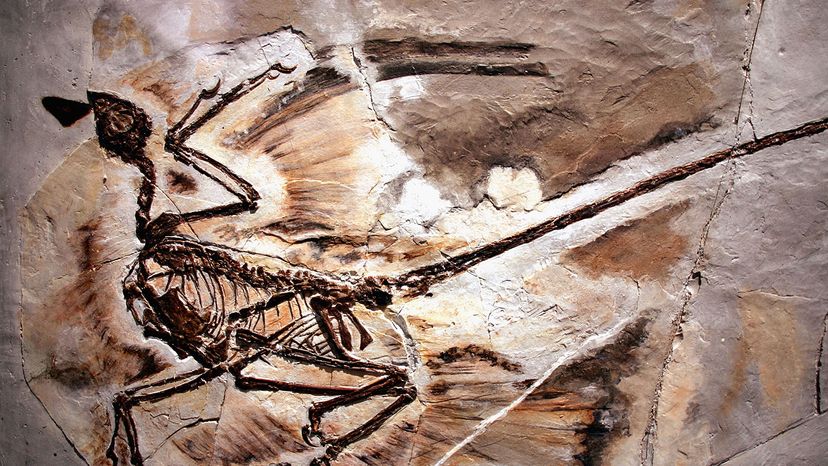
Image: Microraptor fossil from a 130-million-year-old forest/Spencer Platt/Getty Images
About This Quiz
Birds are - quite literally - living dinosaurs. Our quiz will test your knowledge of the fluffy, downy and winged dinos of the bygone Mesozoic Era, from little Microraptor to the enormous Yutyrannus.
All three of these dinosaurs appear in "Jurassic Park" (1993), but none are depicted with feathers on-screen. Which genus probably had some plumage in real life?
Parasaurolophus
Triceratops
Velociraptor
A Velociraptor skeleton described in 2007 had a series of prominent bumps on its forearms. They resemble the "feather quill knobs" that we see in modern turkey vultures.
Archaeopteryx was a famous bird-like dino with wings and a toothy snout. In what geologic period did this creature live?
the Triassic Period
the Jurassic Period
Despite some key differences between Archaeopteryx's arm bones and those of living birds, a 2018 study argued that the Jurassic critter could actively fly.
the Cretaceous Period
True or False: Birds were the first backboned animals to evolve the ability to fly.
true
false
Our feathered friends were beaten to the punch by the pterosaurs, a group of flying reptiles (related to dinosaurs) that filled the skies from 228 to 66 million years ago.
Advertisement
Ornithomimus was a feathered dino that sprinted through North America about 75 to 66 million years ago. What does its name mean?
bird mimic
With its long neck, toothless beak and slender legs, the animal looked a bit like an ostrich, but its name means bird mimic. Juveniles had downy feathers that changed as the animals grew.
ostrich mimic
chicken mimic
Yutyrannus, a fluffy relative of Tyrannosaurus rex, lived on what continent?
North America
Africa
Eurasia
Measuring 25 feet (7.5 meters) from snout to tail, the species was covered in long filamentous feathers, as shown by the fossilized imprints around recovered skeletons.
A fossil that may represent the oldest 'modern fossil bird' was found in 2020 and given this exciting nickname.
Megachicken
Wonderchicken
The skull of this bird (genus Asteriornis), which lived about 66.8 million years ago, has a mixture of chicken and waterfowl-like features.
Superchicken
Advertisement
Here's one who definitely couldn't fly: The turkey-sized Shuvuuia had stubby arms topped with one huge claw apiece. How do some scientists think these appendages were used?
to pick their noses
to rip open insect mounds
This central Asian oddball had a beak, tiny teeth - and a coat of feather-like structures to boot. No wonder its name comes from the Mongolian word for "bird."
to grab ahold of mates
How many wings did the predatory Microraptor have?
two
four
Akin to the better-known Velociraptor, little Microraptor had a pair of wings on its forelimbs - and another set on its hindlimbs. It lived in northeastern China.
six
Various dinos - feathered species included - are preserved with clumps of rocks where their stomachs would've been. What do scientists call those?
gastroliths
Living birds, such as hawks and chickens, swallow pebbles on purpose to aid in digestion. Gastroliths could've also been good mineral supplements for health-minded dinosaurs.
orogenies
tillites
Advertisement
You Got:
/10
Microraptor fossil from a 130-million-year-old forest/Spencer Platt/Getty Images